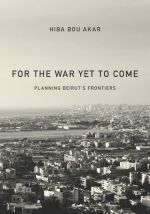For the War Yet to Come: Planning Beirut’s Frontiers

In For the War Yet to Come: Planning Beirut’s Frontiers, architect and planner Hiba Bou Akar describes how the spectre of anticipated war between sectarian groups informs spatial planning practices in Beirut, Lebanon. This morbid vision of the future “forecloses the possibility of an urban politics outside of a sectarian order” (page 10), meaning that planning in Beirut becomes a mechanism for constructing and reproducing irreconcilable differences between people.
It is widely acknowledged that sectarian groups have governed the allocation of resources and delivery of services in Beirut since the end of the Lebanese Civil War in 1990. Bou Akar suggests that these sectarian groups are not merely managing the urban realm, but are engaging in a “series of practices that produce the spatiality of sectarian difference” (page 147). Bou Akar uses the concepts of doubleness, lacework and ballooning as lenses onto sectarian spatial strategies, through which she examines the complex assemblages which enable sectarian groups to (re)produce difference, as well as to seize urban resources.
As a result of these strategies, possibilities for alternative futures in Lebanon, and Lebanese cities in particular, are foreclosed. Peripheries are turned into frontiers, and private homes or commercial buildings can be simultaneously imagined as being paramilitary structures. Residents’ identities are seen as being shaped by planning practices, and land itself is seen as having an ethno-sectarian identity. Alternative subjectivities, socialities, and urban futures are prevented from emerging, as ethno-sectarian groups, together with planners and private property owners and brokers, transform post-war Beirut into militarised spaces. Nonetheless, war is perpetually kept at bay, even as it is being prepared for.
In the literature on urban development, Beirut takes on symbolic significance as a prefigurement for cities where political difference is assumed to be primordial and inherent. In contrast to this assumption, Bou Akar’s focus on “everyday sectarianism”, located in “zones of awkward engagement” between people, and between people and place, has shown sectarianism to be spatially and temporally produced and contingent. She signals “cracks” in the sectarian planning system (page 181). However, alternative futures are still shut out for the majority, creating a differentiated citizenship along class lines as well as sectarian ones.
Taking inspiration from emergent urban initiatives and movements in the capital, Bou Akar ends on a hopeful note: in Beirut, planning has become a practice “around which alternative groups have rallied” (page 185). The “not yet” of urban planning is a source of hope for these alternative groups, who seek to maintain the possibility of urban politics outside of sectarianism.
More information:
https://www.sup.org/books/title/?id=25764
Further reading:
Bollens, S (2012), City and Soul in Divided Societies, Routledge, London.
Fawaz, M (2014), “The politics of property in planning: Hezbollah’s reconstruction of Haret Hreik (Beirut, Lebanon) as case study”, International Journal of Urban and Regional Research Vol 38, No 3, pages 922–934, available at https://doi.org/10.1111/1468-2427.12114.
Randa Nucho, J (2011), Everyday Sectarianism in Urban Lebanon: Infrastructures, Public Services and Power, Princeton University Press, Oxford.
Book note prepared by Hannah Sender
Search the Book notes database
Our Book notes database contains details and summaries of all the publications included in Book notes since 1993 - with details on how to obtain/download.
Use the search form above, or visit the Book notes landing page for more options and latest content.
For a searchable database for papers in Environment and Urbanization, go to http://eau.sagepub.com/

